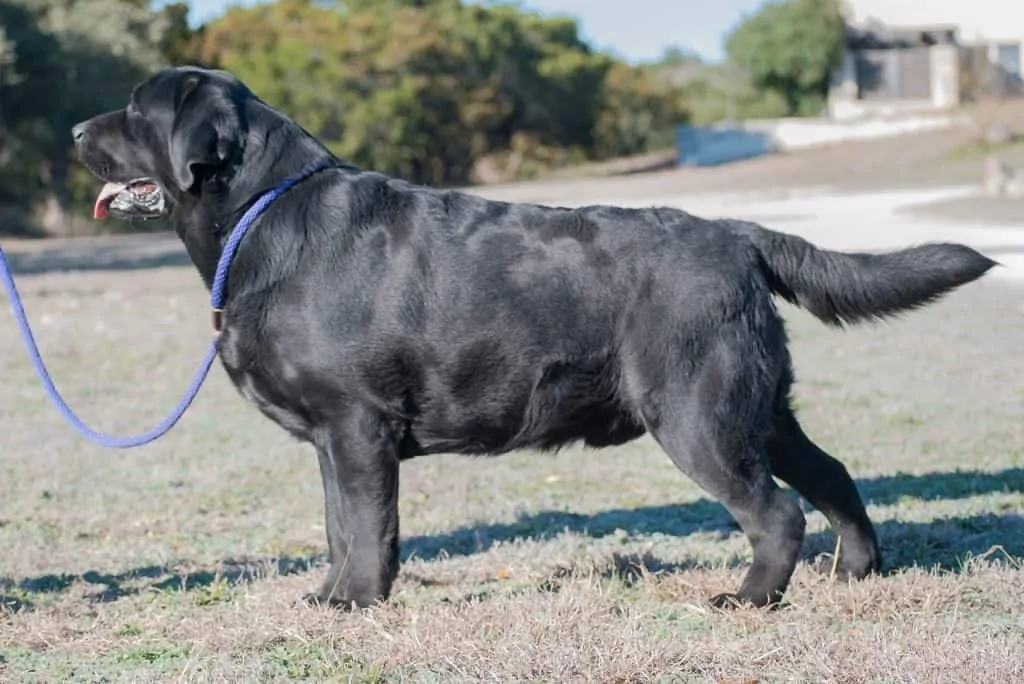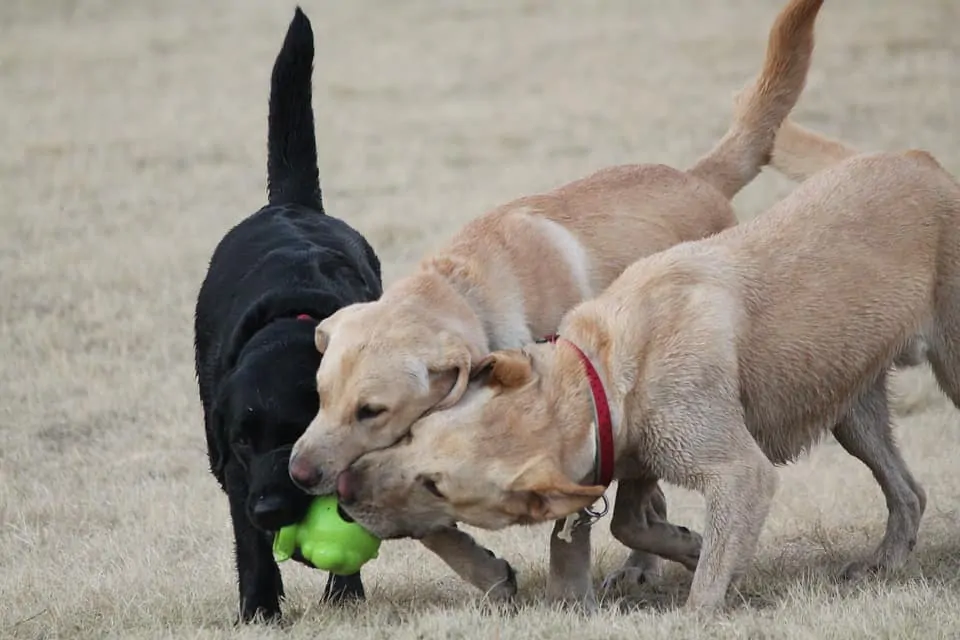By far the most popular dog in the world, the Labrador retriever is a common sight at dog parks and in suburban neighborhoods. This breed’s happy, energetic personality and propensity for getting along with just about everyone has earned them the kind of adoration that few breeds receive.
But just because these dogs are wildly popular doesn’t mean they are right for everyone. Keep reading to find out if this well-known retriever is right for you.
Contents
General Characteristics of the Labrador Retriever
- Other names: Lab
- Height: 21 inches to 25 inches
- Weight: 55 to 80 pounds
- Lifespan: 10 to 12 years
- Origin: Labrador, Canada/Britain
- Colors: Black, yellow, or chocolate
- Activity level: Medium-high
- Grooming needs: Minimal
- Best suited for: Active families
The loyal lab has earned its reputation as the world’s most popular dog thanks to its dependable, fun-loving, and affectionate nature and willingness to do just about anything that is asked of it.
The History of the Labrador Retriever
The lab was first developed in Labrador, a region of Newfoundland, Canada, as a fisherman’s helper in the late 18th century. They would assist in pulling in fishing nets and retrieving fish and equipment that escaped the fisherman’s grasp.
Their thick, short coats were ideal for keeping the dogs warm even when wet. And their natural extra layer of fat allowed the dogs to work in near-freezing water without issue.
In order to do their jobs successfully, these dogs had to have the right personality. They needed to be able to work happily alongside other dock dogs and crowds of different people. They also needed to be good-natured enough for the fishermen to bring home in the evenings.
This friendly temperament combined with a high intelligence and drive to work attracted the interest of English traders who frequented the area. Eventually, they brought some of these Labrador dogs back to their home country.
In Britain, the dogs were most often used as gun dogs. Their natural retrieving instincts, sharp nose, and soft mouth made them perfect for fetching downed fowl. They were so good for this task, in fact, that they caught the attention of many nobles.
The Earl of Home and Duke of Buccleuch were some of the earliest owners of the breed. These nobleman worked to refine the lab into what we see today.
While they were originally bred to retrieve fishing nets, it was the lab’s ability to find and return downed fowl to their owners that truly led to their popularity.
Most of these original dogs were black in color. It wasn’t until the late 1800s that the first chocolate and yellow labs were documented.
By then, the reputation of the lab as a loyal gun dog, waterfowler, and family companion had spread far and wide. By the end of the 20th century, the dog had become one of the most popular breeds in many countries around the world.
Today, the lab is still widely used as a hunting retriever, but is most popular as a family pet. Their keen intelligence has also earned them a place in the military and as a service animal.
The Temperament of the Labrador Retriever
The Labrador is an all-around good-natured canine with a love for family and a zeal for life.
They are typically very sociable dogs who enthusiastically greet every person they meet. While they are known to “alarm bark” when they hear strange noises, they are by no means guard dogs. They are more likely to lick an intruder to death than bite them.
They are retrievers at heart and love to chase balls, often for hours without end. This energy can be redirected to other tasks including scentwork, agility, and trick training. If not given a job, they can become destructive and obsessive.
This is especially true of adolescent dogs, who tend to have an excessive amount of energy. Because labs tend to mature late, around three years of age, this “hyper,” immature phase can last longer than many owners are prepared for.
Still, the lab is a highly intelligent dog–ranked number 7 on Stanley Coren’s list–and is easy to train if given enough time and attention.
More than anything, the lab was built to please. At a close second, they were built to eat! Whether through hugs and pets or treats, it is easy to find your way into a lab’s heart.
This combined with their easy-going temperament and drive to please is one reason they are so often used as service animals. Guide Dogs for the Blind use labs almost exclusively. They are also one of the preferred breeds for bomb detection and search and rescue.
Overall, the lab is a loyal, sociable companion who needs plenty of exercise and attention. They enjoy time with family, but need something to occupy their attention, especially early on.
Health Issues Common to the Labrador Retriever Breed
Overall, the Labrador retriever is a robust breed. Unfortunately, their popularity has led to a lot of less-than-optimal breeding which has increased the occurrence of health issues. Some of the most common being:
- Cancer
- Elbow and hip dysplasia and luxating patella
- Eye issues such as progressive retinal atrophy and cataracts
- Diabetes and obesity
- Heredity myopathy
- Exercise induced collapse
More so than any other breed, Labradors are prone to obesity. This quirk has a lot to do with their original purpose.
In order to swim and retrieve nets and fish in the frigid waters of Newfoundland, fishermen selected dogs with a higher amount of body fat. Over time, this selection process led to a genetic change that is seen in all modern labs.
The deletion of PMOC genes in the breed has created a dog with increased interest in food and a higher susceptibility for obesity. For owners, this means you must be extra careful in portioning food for your Labrador based on their size and activity level, not on how hungry they act.
The lab is a naturally thick canine that is supposed to look sturdy. But this “sturdiness” can easily turn into obesity if you aren’t careful. Work with your vet to determine if you pup is at the right weight or in need of a diet.
Allowing your dog, whether lab or otherwise, to gain excess weight can lead to health problems. Joint issues, including hip dysplasia, can be aggravated by obesity. Metabolic issues and certain cancers are also more common in overweight animals.
In addition to feeding appropriately, you can also help guarantee your dog’s health by only purchasing lab puppies from reputable breeders. There is no shortage of backyard breeding with this dog, so it is important to research your breeder, visit their facility, and meet the parent dogs before you commit to them.
If you would rather adopt, there are hundreds of pure and mix breed labs currently in shelters waiting for their forever home. There are also a number of breed rescues around the country.
Do Labrador Retrievers Do Well With Children and Other Pets?
As you can probably guess, the Labrador retriever tends to make a great family dog. They do well with children of all ages, but due to their size, do need to be watched around babies and toddlers. They make great playmates for older children, especially kids who enjoy playing fetch.
A history of being used to fetch nets in freezing water has created a dog with incredibly high pain tolerance which means the lab is less likely to bite a pestering child than many breeds. With proper socialization early on, the Labrador can be a bomb-proof family companion for just about any situation.
This sociability also extends to other canines. Most labs are very happy to play with other dogs of all sizes and types. Again, early socialization is key to getting an adult dog that can play and communicate well with others.
Despite their long use as hunting dogs, these retrievers have little hunting instinct themselves. This makes them good housemates for cats and other pets. Always introduce them slowly to new family members and use positive methods to reinforce a harmonious relationship.
It is not uncommon for hunters to use multiple dogs when out at the ponds. Each dog is capable of discerning commands meant for them over commends meant for another. Once the work is over, labs love to play with each other and other dogs.
What to Consider Before Bringing Home a Labrador Retriever
Think you, like so many others, can provide the right home for a lab? Here are a few more things to consider before bringing one of these high energy pups home.
Activity Level
The key to a well-behaved lab is exercise and training. Both of these are supremely important during the first two years of life when labs have the most energy.
These retrievers make great running partners and are perfect for dog sports like dock jumping, flyball, and frisbee competitions. All of these are also great ways to keep that excess energy in check. If you don’t have time to wear your Labrador out yourself, you should consider getting a membership to a local doggy daycare or at least frequenting the dog park.
Once labs hit maturity, they tend to slow down some, but are likely to need at least one long walk and one good fetch session everyday until they reach old age.
Trainability
The Labrador is highly food motivated and very intelligent, two traits that make them fairly easy to train. They also live to please, so as long as they get consistent, positive direction, they tend to pick up new behaviors and rules quickly.
One personality trait the lab possesses that does make training a bit tricky is an excess of enthusiasm. While this seems like it would only aid in the training process, at times, it can be detrimental. Loose leash walking is one area where this issue is all too obvious. Too much excitement over getting out of the house can easily overwhelm a love for treats or need to please. For this reason, all training, but especially leash training, should begin when your dog is just a pup.
Trick training is another great way to engage your hyperactive lab. With some kibble for motivation and a little patience, it is possible to teach these dogs to do just about anything on command.
Grooming
Grooming a lab is as simple as running a brush through their double coat once a week. During the spring and fall shed, this may need to be increased to multiple times per week (or at least, you’ll need to vacuum more), but this is generally the hardest part about grooming a lab.
Like all dogs, they need their teeth brushed daily and their nails trimmed frequently.
Nutrition
The lab is an easy keeper and will do well on any high quality commercial or homemade diet. The most important factor in feeding a lab is to keep portions reasonable. No matter how much you feed a Labrador, they will still act hungry–it’s in their genes! By matching feeding quantity to your dog’s activity level and age, and ignoring the constant requests for treats and table scraps, you should be able to keep them fairly trim.
Cost
A purebred lab puppy can cost anywhere from $300 to $1000 or more. These dogs typically come in two types: English labs and American labs.
English labs (or the more specialized British labs) represent the show standard for the breed. They tend to have boxier heads, shorter legs, and more closely resemble the original fishermen’s dog. These varieties tend to be more expensive because they more closely meet the show standard.
The American lab, or hunting lab, is taller, sleeker, and has a narrower head. These dogs are bred more for their athleticism and retrieving skill than their looks. These are more common in the US and tend to be less expensive unless they come from premier hunting lines.
American labs, like this one pictured above, tend to be more athletic than their British cousins and have the sleek build to prove it. These dogs would never last in the cold waters of Labrador, but they make great hunting dogs.
10 Fun Facts About the Labrador Retriever
Now that you know a little about what it takes to own a lab, here are some fun facts about the breed.
- The Labrador’s short coat was essential in the cold north where longer coats were prone to freezing solid once a wet dog emerged from the water.
- President George H W Bush used a Labrador named Sully as a service dog in his later years. The dog famously attended the president’s funeral.
- On September 11th, two labs led their blind owners safely out of the World Trade Centers as fires raged. Both were awarded the Dicken Medal of devotion, afterwards.
- The lab’s thick, straight, otter-like tail is used as a rutter while they swim, allowing them to maneuver quickly in the water.
- Limber tail is a condition in which a lab’s tail goes limp after a day of swimming. This usually occurs when the water is excessively cold and will reverse itself after a few days.
- Like all great water dogs, labs have webbed feet.
- It is possible for all three colors of labs to be born to the same litter.
- Black labs are still the most common color, followed by yellow, and then chocolate.
- The chocolate coloring is a recessive gene and is associated with a shorter life expectancy, likely due to a smaller gene pool in lines with a high occurrence of this coloring.
- Red labs, a darker variant in the yellow gene, and silver labs, a dilution mutation likely introduced from crosses with Weimaraners, are also bred by novelty breeders but are not considered standard colors for the breed.
Before You Go
Not sure the enthusiastic lab is for you? Here are a few more breeds to consider.

Sara Seitz has spent most of her life in the pet industry and has a bachelors in animal behavior from Colorado State University. Sara started working with dogs and cats as a high schooler at a rural boarding kennel. There she learned a lot about the bad and the ugly of the pet service industry. But not even the toughest day at that job would dissuade Sara from following her dream of working with animals.
In college, Sara got a job at a dog daycare and boarding facility in Fort Collins, Colorado. Her new career provided even more opportunities for learning about dog behavior than her classes did. As general manager of the daycare, Sara helped the company launch a new in-home pet sitting branch and trained to become a certified dog trainer. Between shifts taking care of peoples pets in-home and supervising dogs during playtime at the daycare, Sara organized and taught obedience classes.
Sara has always been passionate about bettering the lives of our canine companions. She soon found that advocating for and educating owners in the power of positive reinforcement training was one of the best ways to help dogs and their owners live happier lives.







